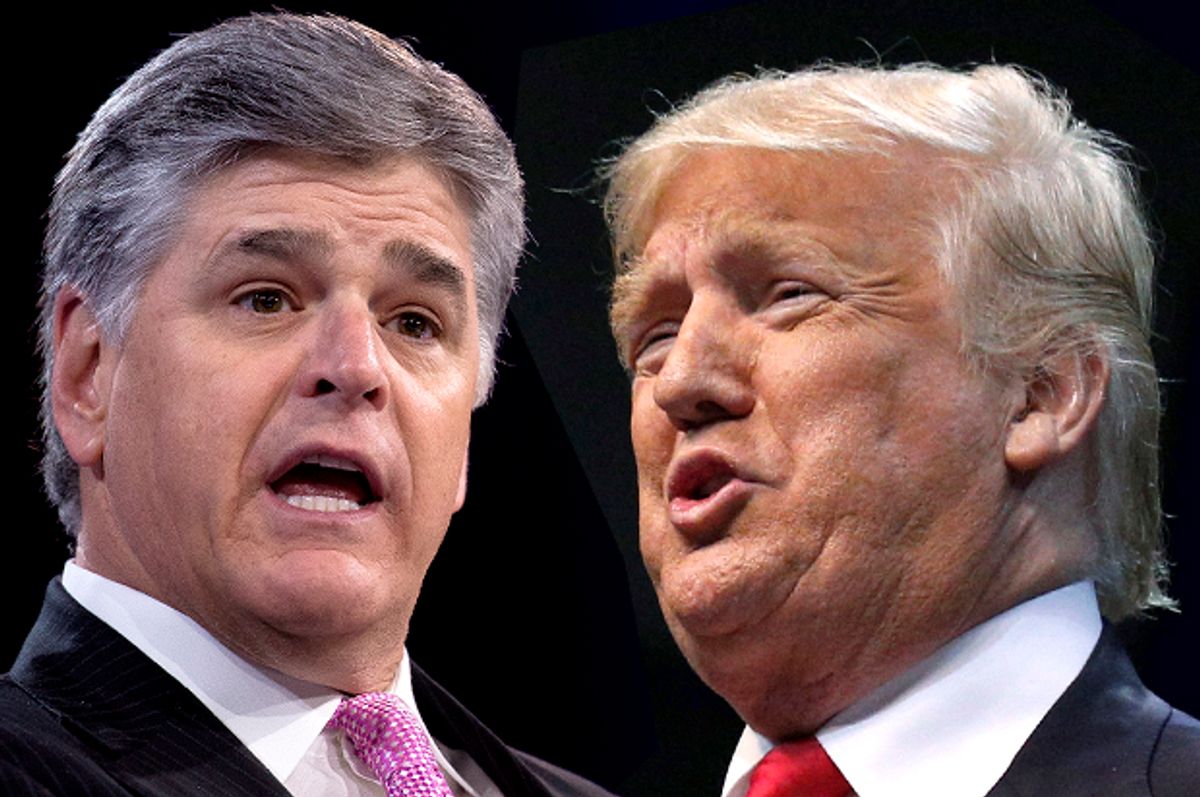Sean Hannity had a busy weekend on Twitter. The Fox News host and “street martial arts” practitioner had a fire lit underneath him upon hearing that President Donald Trump had accused Barack Obama of ordering wiretaps at Trump Tower during the 2016 presidential campaign. As any good journalist would, Hannity took Trump’s statement at face value and immediately set about trying to get answers.
That quest involved spending all of Saturday rage-tweeting variations of “What did Obama know and when did he know it” at former Obama staffers. Shortly after midnight on Sunday morning, Hannity put the final touch on this journalistic achievement by tweeting out a Breitbart article about how he’d “grilled” the former president and his aides over the issue.
The problem with all this is that Trump seems to have made the whole thing up. The president apparently came across a Breitbart analysis of a rant by conservative radio host Mark Levin and leaped to the conclusion that the former president had directed an espionage campaign against Trump Tower. While Hannity was confidently trolling Obama alumni on Twitter, Trump staffers in the White House spent their Saturday in lockdown trying to figure out what the hell their boss was talking about. “White House sources acknowledge that Trump had no idea whether the claims he was making were true when he made them,” noted The Weekly Standard.
So in the world of observable, testable reality, Donald Trump’s accusations against his presidential predecessor are (under the most generous interpretation) unproved. The White House has presented zero evidence to substantiate Trump's claims. But conservative media personalities like Hannity have aggressively and enthusiastically created an alternate reality in which Trump’s statement is self-evidently accurate and, as a consequence, former officials for Obama could now be in legal jeopardy.
Media balkanization is by no means a new phenomenon, but a new study by Columbia Journalism Review has found that pro-Trump propagandizing of this sort is having a measurably deleterious effect on how all media outlets cover Trump. The review identified Breitbart News as the gravitational locus of a conservative media galaxy that pumped out “disinformation” throughout the 2016 presidential campaign: “This turned the right-wing media system into an internally coherent, relatively insulated knowledge community, reinforcing the shared worldview of readers and shielding them from journalism that challenged it.”
This happens to a certain degree with all people: They seek out information that confirms their biases and are skeptical of information that challenges them. What Columbia Journalism Review discovered, however, is that conservative media outlets in the Trump era are far more effective at walling off their audience from any information that doesn’t comport with their preferred narratives.
“By repetition, variation, and circulation through many associated sites,” the review observed, “the network of sites make their claims familiar to readers, and this fluency with the core narrative gives credence to the incredible.” Once a source for disinformation is validated by like-minded sources, suddenly an allegation becomes “true” even if the person making it — in this case, the president of the United States — can’t put any factual weight behind what was said. Consumers of right-wing news see Sean Hannity go on the warpath against Obama associates on Twitter, then they read Breitbart’s write-up of Hannity’s tweetstorm, and subsequently they turn to Fox News and watch right-wing pundits talking about Obama’s “Soviet-level wrongdoing.”
The potency of this disinformation machine and its close ties to the White House will necessarily affect how mainstream outlets cover the news. Reporters and publications who report with justifiable skepticism on Trump’s “wiretapping” claims will come under attack from Breitbart, Hannity and others as part of the conservative media’s long-running effort to discredit mainstream publications. That provides incentives for journalists to strain for forced objectivity and give undue weight to discredited conservative narratives in the name of “balance.”
Even if reporters don’t succumb to that temptation, the time they spend knocking down the falsehoods and half-truths emanating from the right-wing media is time not spent reporting for other stories. Dealing with all this misinformation is exhausting because the self-reinforcing nature of the conservative media bubble means that external fact-checks carry no weight.
The Columbia Journalism Review counsels that the first step to effectively combatting the toxic conservative media bubble is for the mainstream press to recognize “that it is operating in a propaganda and disinformation-rich environment.” Another key thing to understand is that propaganda and disinformation enjoy a direct pipeline to the Oval Office, where it is consumed, validated, exploited and used to direct policy. Cutting though the nonsense that emanates from this toxic interplay between the president and his media enablers will be one of the greatest challenges of the Trump era.

Shares